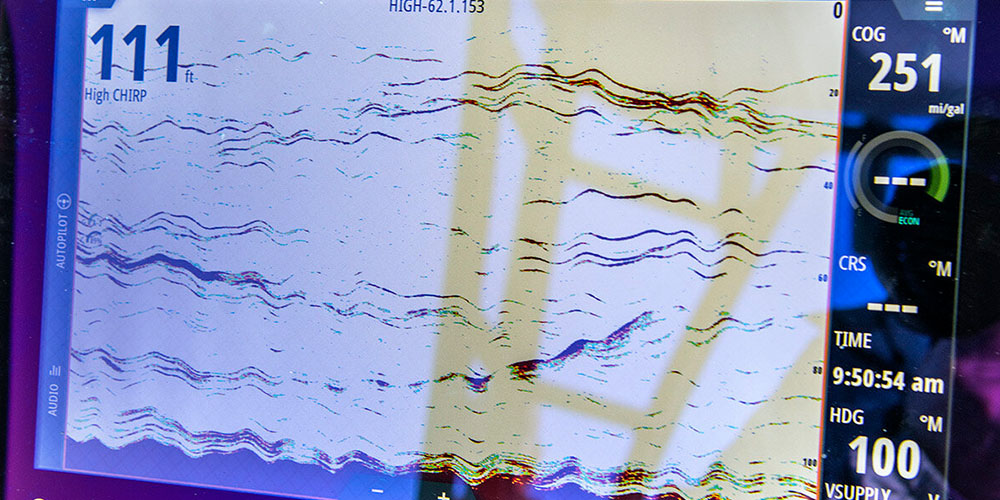
Bottom line: CHIRP sonar gives you a better view of fish and is miles ahead of old-school single-frequency, dual-frequency or even triple-frequency transducers. We'll help you to understand CHIRP, and what investing in a compatible fishfinder can do to improve your fishing and boating.
Traditional Fixed-frequency Sonar
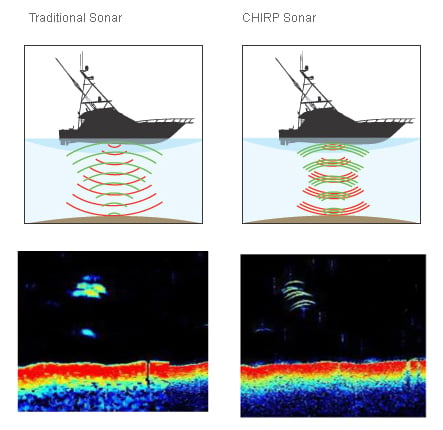
CHIRP sonar resolves images better than the traditional sonar we’ve been using for decades.
Traditional sonar transmits a powerful ping, or pulse of energy into the water column at a specific frequency, then “listens” for the echoes to return. The unit’s software then processes this information to create the image of the bottom, structure and fish that you see on the display’s screen. This type of “tone burst” energy pulse may be high in power, but it is very short in duration. This limits the total amount of energy that can be transmitted into the water column.
Different frequencies reveal different levels of detail. For example, a high-frequency 200kHz pulse provides excellent detail, but can’t penetrate very deeply into the water. A low-frequency 50kHz pulse penetrates deeper but reveals less detail. This is why most traditional sonars now use at least a dual-frequency or even triple-frequency transducer to provide a good combination of depth and detail.
CHIRP Sonar with Ascending Frequency Range
CHIRP (an acronym for Compressed High-Intensity Radiated Pulse) is a game-changing technology that has been used by the military for decades in both radar and sonar. CHIRP technology began filtering down to recreational sonars in about 2009.
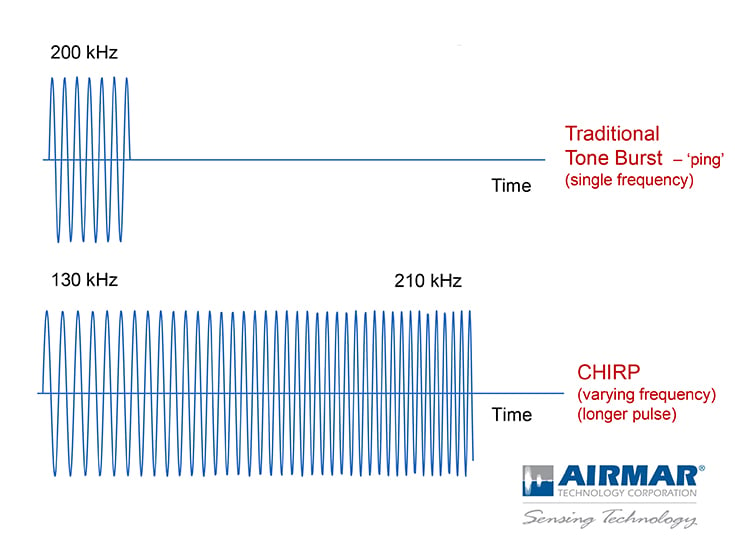
CHIRP fishfinders transmit a longer pulse than traditional sonar, putting more energy into the water column, with a true broadband frequency range of up to 117kHz.
Instead of pinging a single frequency like traditional 2D sonar, CHIRPing devices transmit a sweeping range of frequencies. With each pulse, the transducer starts vibrating at a low frequency, which is then modulated upward to a high frequency over the duration of the pulse (130 to 210kHz, for example).
A traditional sonar transmits about one percent of the time, but CHIRP sonars transmit ascending pulses that are ten times as long in duration. They put dramatically more energy into the water column, 10 to 50 times more, even though CHIRP devices often transmit at lower peak power than traditional fishfinders.
Pulse Compression and Pattern Correlation
Using advanced digital pattern matching and signal processing, known as “pulse compression,” CHIRP devices receive and process dramatically more information from each pulse, enabling them to achieve unprecedented resolution and target definition.
The pulse compression process, used in both radar and sonar systems, converts a long duration frequency-coded pulse into a narrow pulse of highly increased amplitude. A narrow pulse with high peak power can be correlated from a long duration pulse with low peak power, increasing the range resolution and improving the signal to noise ratio, giving the device greater ability to pull targets from the background noise.
CHIRP improves bottom tracking at higher speeds and deeper depths. It helps resolve individual targets—no blobs, but instead crisp separation of adjacent objects. The result is a spectacular improvement in the image you see.
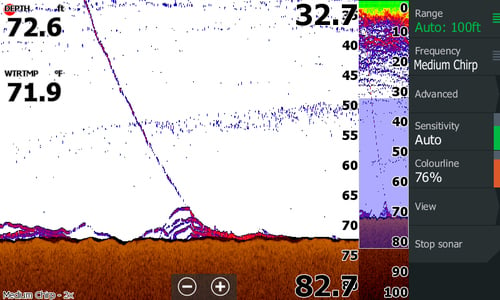
View on medium CHIRP showing fishing line.
CHIRP Frequencies
Which CHIRP frequencies should you choose? The basics are similar to the traditional 2D sonar:
- High CHIRP (150–240 kHz) is for inland and freshwater; best choice for lure tracking, identifying game fish and baitfish targets, or for targeting game fish near bottom structure. Best for depths less than 600 feet
- Medium CHIRP (80–160kHz) displays a wider coverage area, scanning large areas more quickly, showing larger fish arches but providing less detail than high CHIRP for seeing smaller objects. Like high CHIRP, it’s best for depths less than 600 feet
- Low CHIRP (below 80 kHz) is used in deep water over 600 feet, offers amazing depth performance (up to 10,000 feet) and marks targets at all depths in the water column
Better quality CHIRP fishfinders let you see two CHIRP frequencies on screen at once. So you can sweep a broad cone on the medium frequency CHIRP band. Then, when you find something that looks good, get a closer look on the tighter-focused high CHIRP setting.
The Arrival of “Cheap CHIRP”
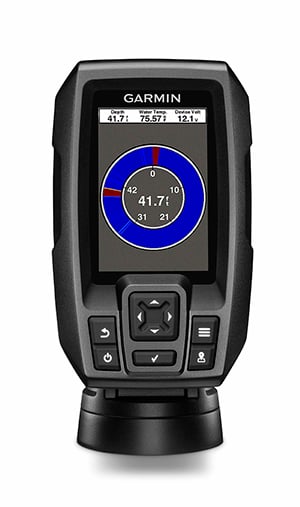
Garmin's Striker™ 4 Fishfinder includes a dual beam 77/200kHz CHIRP sonar, a color display and GPS to mark your favorite fishing spots.
How affordable are these CHIRP-enabled fish finders, and what are the differences across the range of prices for a CHIRP sonar?
When this technology first showed up on the market, CHIRP could only be found in expensive sonar modules costing a couple thousand dollars. They were made for the pros and for offshore fishermen looking for the latest technology, regardless of price. Today, CHIRP fishfinders, either sonar modules or chartplotter/fishfinder combos, are available in every price range.
Here are some of the premium features found on the most expensive offshore CHIRP sonar modules:
- Two independent CHIRP channels: Operate two independent transducers or one transducer covering two CHIRP frequency ranges, with ultra-low, low, medium, or high frequencies, to suit your style of fishing and the species you target
- Ability to customize frequencies: A traditional fixed frequency mode allows you to manually adjust frequencies (from 25kHz to 210kHz, using the Garmin GSD™ 26 CHIRP Professional Sonar Module, for example) for enhanced targeting of specific fish species
- Lots of transmitting power: Adjustable from about 300 RMS watts all the way to 3kW or 4kW, for extreme depth ranges
- Compatibility with many transducers: These include Airmar’s latest wide-angle 25° CHIRP series
- Part of an NMEA 2000 network: These modules work with high-end displays as one component of a network. A large, high-resolution LCD display is necessary to see all of the details from the powerful CHIRP sonar
Mid-priced CHIRP fishfinders often include a single CHIRP channel, usually with a transmitting power of 500W or 600W. Scanning sonar, enhanced with CHIRP technology, is often built into the unit and its matched transducer. You can see CHIRP, side-scan and down-scan sonar, all on the same screen. For the typical inland or coastal angler, these fishfinder/chartplotter combos have all the functions you’ll ever need. Two versions are often sold; a coastal model, with appropriate mid/high-frequency transducer and coastal charts, or an inland version with high-frequency transducer and inland lake charts. The price is often proportional to the size and resolution of the LCD screen.
Affordable CHIRP sonars, the “cheap CHIRP” for the rest of us, are made for the inland angler, and are the newest on the market. Various models come as a standalone fishfinder, sonar with GPS (but without charts), or a sonar/chartplotter including either inland or coastal maps.
Whatever your price range, CHIRP sonar has changed the fishfinding game.
FAQs
What is CHIRP sonar, and how does it work?
CHIRP (Compressed High-Intensity Radiated Pulse) sonar is a technology used in marine depth sounders that provides a more detailed and clearer picture of what’s below the boat. Instead of emitting a single frequency like traditional sonar, CHIRP sonar sends a range of frequencies (low to high) at once. The sonar system then interprets the returning echoes from these varied frequencies to create a higher resolution, more accurate image of the underwater environment. This improves fish detection, structure imaging, and bottom profiling.
What are the advantages of CHIRP sonar over traditional sonar?
CHIRP sonar has several key advantages:
- Improved Image Quality: It provides more detailed, sharper, and higher-resolution images, making it easier to distinguish between fish and structures.
- Better Depth and Target Separation: CHIRP sonar can more accurately separate targets at different depths, especially in deeper water.
- Extended Range: CHIRP sonar can detect fish and structures at greater depths than traditional sonar, providing clearer images at both shallow and deep depths.
- Less Interference: The use of a broader frequency range reduces interference from other sonar systems.
Do I need a special transducer for CHIRP sonar?
Yes, a specialized CHIRP transducer is required to take full advantage of CHIRP sonar technology. Traditional sonar transducers operate at a fixed frequency, while CHIRP transducers can transmit and receive multiple frequencies. These transducers are designed to handle the wide frequency ranges needed for CHIRP, ensuring you get the maximum performance from your sonar system.
How do I interpret the images from a CHIRP sonar?
Interpreting CHIRP sonar images involves understanding the different signals on the display:
- Fish Arch or Fish Symbols: Fish will often appear as arches or solid symbols, depending on the display settings. The size and shape of these arches can give an indication of fish size and depth.
- Bottom Structure: The bottom will show as a line that varies in depth, with structures like rocks, wrecks, or reefs appearing as distinct shapes or clutter.
- Fish Density: Clusters of fish or schools will often appear as dense masses, while individual fish are often shown more distinctly.
- Color Palette: Most modern sonar systems use color coding to represent the strength of the return signal. Typically, warmer colors (reds, yellows) represent strong returns, indicating solid objects or fish, while cooler colors (blues, greens) indicate weaker returns, such as softer or less defined objects.
What is the best frequency to use for CHIRP sonar on a boat?
The best frequency for CHIRP sonar depends on the type of fishing or boating you’re doing:
- Low-frequency CHIRP (40-60 kHz): Best for deeper water, typically greater than 300 feet (90 meters), as it penetrates deeper and provides broader coverage but with less detail.
- Mid-frequency CHIRP (80-160 kHz): Ideal for shallow to medium depths (15-300 feet). This provides a good balance between range and clarity.
- High-frequency CHIRP (150-250 kHz): Perfect for shallow water (0-150 feet), providing the clearest and most detailed images, but with a reduced range.



